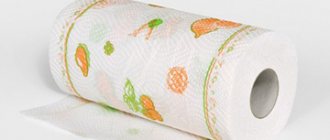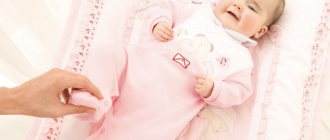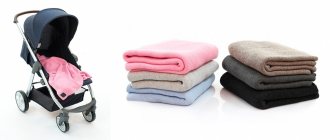Expectant mothers are often concerned with questions: how to prepare for the arrival of a baby in such a way that there is enough of everything and no unnecessary worries arise; how many diapers does a newborn need every day? How much should I take with me to the hospital? Is it worth using them at all?
How much should I take to the maternity hospital?
The list of things needed for the maternity hospital necessarily includes disposable blotting cloths. They need to be prepared in advance. The most important thing is to decide how many diapers a newborn needs per day, so as not to overload the “emergency” bag for a trip to the hospital.
You can calculate the number of diapers for a maternity hospital like this:
- Consider the approximate length of stay of mother and baby in the hospital. During a normal birth, without complications, the woman and baby are discharged home after 3–4 days. After cesarean section, the period is extended by 5–7 days.
- Newborn babies pee rarely - up to 10 times. At the same time, the volumes of liquid released are also small. You will have to change a wet diaper without feces 4-5 times a day.
- On days 2–3 of life, babies begin to pass meconium. There can be a lot of it, so the need for clean diapers these days will increase to 10 pieces.
Based on the data obtained, we will make simple calculations. If a woman stays in the maternity hospital for 4 days, then on the first and second days the baby uses an average of 5 waterproof pads, and on the third and fourth days - 10.
There are 30 pieces in total. The result turned out with a reserve; on average, 20–24 copies are enough for this period.
On a note! In maternity hospitals, diapers for newborns are issued every day, 15–20 pieces per baby. Pediatricians recommend swaddling babies during the day and wearing diapers only at night. With this approach, you will have to take no more than 10 diapers to the maternity hospital.
Criterias of choice
There are many companies on the market that produce baby diapers. How to make the right choice of products that are ideal for your baby? The most expensive does not always mean the highest quality and most convenient. To begin with, you can buy several pieces produced by different companies. The size must be selected according to the baby’s weight.
Pay attention to rubber bands and Velcro. They should not be too tight so as not to squeeze your baby’s legs.
The baby's reaction will help you make the right choice. If he frolics and is not capricious, and the skin remains dry, without diaper rash and signs of chafing, the quality of the product is considered satisfactory and you can safely continue to use it.
A comparative table of the main advantages of Pampers diapers will help mom make her choice
How many diapers do you need per day?
Calculating how many diapers your baby needs per day is necessary in order to have a supply of panties at home. Children from birth to 1.5–2 years old wear diapers every day. During infancy, quite a lot of them are used; as babies grow older, the number of waterproof cloths gradually decreases.
Pediatricians advise changing diapers with the following frequency:
- After every poop.
- Before bed, after sleep, before and after feeding.
- Every 3-4 hours, if the baby only pees.
- Before the street and after a walk.
- After bath.
If you follow the recommendations of children's doctors, a child up to six months needs 10-12 diapers per day, after six months - 6-8 pieces, by a year and a half - 4-5. Plus a few more copies for unforeseen situations.
On a note! Diapers with absorbency up to 120 ml are designed for 3-4 hours, with a moisture retention rate of 160 ml - for 5-6 hours, night diapers with absorbency up to 240 ml - for 8-12 hours. Pay attention to this indicator when buying panties for sleep and daytime play.
Diaper consumption by month
The consumption of diapers depends on the age of the child, his individual physiological characteristics and the absorbency of waterproof fabrics.
During the newborn period, from 1 to 7 days, children secrete up to 120 ml of fluid, by the end of the first week and up to one month of age - up to 300 ml per day. If the child eats well, the kidneys and gastrointestinal tract work at an increased rhythm, and 30–50% more urine is produced.
By six months, babies pee more often and more abundantly. The amount of urine increases to 500–750 ml per day. This figure hardly changes by the age of one, it’s just that children release urine less often, not 12–16 times, as at the age of six months, but 10. At 3 years old, babies go to the toilet 4–6 times a day, the amount of urine increases to 800–900 ml.
Thus, when choosing a diaper, be sure to consider its absorbency. This will help you use fewer blotter cloths and save on their purchase, especially in the first six months of a baby’s life. A good indicator for children under one year old is absorption within 160 ml, by 3 years - 240 ml.
A table that takes into account your baby's urinary needs, average urine volumes for each age, and the diaper's ability to absorb stool will help you calculate how many diapers a newborn needs per month. To the figure obtained after calculations, we added another 2-3 diapers for bowel movements. Children 1-2 months old poop up to 8 times a day, by six months - 2-3 times, from one year to three - once.
(Important! The table can be scrolled left and right)
| Child's age | Average daily urine volumes, ml | Number of urinations, pcs. | Diaper absorbency, ml | Approximate number of diapers per day, pcs. | Approximate number of diapers including pooping, pcs. | Total number of diapers per month (30–31 days), pcs. |
| From 1st to 5th day | 60–120 | 4-6 | 120 | 4-5 | 4–6 | 120–150 |
| From 6 to 28 days | 120 | 8–10 | 120 | 6 | 8 | 180-240 |
| From 1 to 6 months | 300–650 | 20 | 120 | 8–10 | 7-9 | 240–260 |
| From 6 months to 1–2 years | 400-750 | 15–18 | 160 | 5–7 | 10–12 | 150-200 |
| From 2 to 3 years | 800–900 | 6-8 | 240 | 0-3 | 0–4 | 0–120 |
According to the table, it is easy to calculate the daily and monthly costs of children's blotting cloths. If a diaper costs 15 rubles, then purchasing them for a one-year-old child will cost approximately 3 thousand rubles per month.
If you buy a year's supply at once - about 40 thousand. The amount turns out to be quite large, so try to buy diapers in a large pack, start putting your baby on the potty closer to a year, gradually giving up waterproof pads.
On a note! The results obtained are approximate. If you use ordinary panties, diapers, gauze blotters and disposable diapers alternately during the day, then the number of diapers per month and the costs for them are reduced by 40–50%.
How often should I change
The health of the child’s skin, his mood and calmness during walks and sleep depend on the frequency of changing diapers. There is no need to specifically save on blotting cloths, trying to use less, or waiting for maximum fullness. Change your diaper immediately without delay if:
- The baby craps himself.
- Put your baby to bed.
- You are going for a walk, to visit, to see a doctor.
- After bathing, washing, even if the child did not have time to pee in the used diaper.
- The skin under the diaper became damp and stiff.
In other situations, focus on the volume of urine excreted by the baby. For example, you know that your child pees a lot at night and may crap himself - don’t be lazy to check your panties for fullness 2-3 times before the morning.
If you are going for a walk or driving long distances, and you won’t have the opportunity to wash your butt and put on clean underwear, do all the procedures before leaving the house.
Another important aspect is the time of year and room temperature. In the summer outside, in the winter at home, a child wearing a diaper experiences discomfort.
Butt may be hot. If the apartment is too warm during the heating season, the temperature remains at 25–30°C, take off your waterproof panties more often and take air baths.
In such conditions, it is important for the skin to have access to fresh air. In the summer, you can wear gauze panties with liners outside; this is more hygienic for the dermis. Even if the child wets himself, he will definitely not freeze.
Thus, for children under one year of age, diapers are changed approximately 4–5 times during the day, and at night most often they are not removed at all. After a year, diapers are used less and less during the day, and only one is left for nighttime sleep. But these data are individual and depend on many circumstances.
By the way! It was only recently that mothers were allowed to take disposable diapers to the maternity hospital. Until 2011, newborn babies were only wrapped in cloth diapers before being discharged home.
And here’s what Dr. Komarovsky advises on this matter:
Reducing the number of diapers: small home tricks
At first, it will seem to you that your reserves are disappearing at an exorbitant rate. A few useful tips will help to significantly reduce the process of “evaporation” of diapers. Take note:
- If the room where the baby is located is warm (above +21), there is no need to wear the product to the baby when he is walking. A vest and an oilcloth lined with a diaper will keep the baby comfortable. An excellent option is reusable diapers, sold in all pharmacies. However, there is one nuance arising from the gender of the newborn. The boys release such a stream that not only their diapers become wet, but also the walls and furniture. Lay your son naked on his stomach.
- Advice for babies under 2 months of age. Use a waterproof product as needed when going outside or wearing it at night. The rest of the time, use diapers. For children over 2 months old, rompers are suitable.
- The practice of many attentive mothers shows: if you hold the newborn over the basin immediately after feeding, he will definitely pee. Then you can put the product on.
If the house is warm, you need to periodically provide the child with the opportunity to be without diapers.
Should you wake up your baby at night?
In the first month of life, babies can rarely sleep through the night, so there is no need to wake up children specifically to change diapers. They wake up from hunger, discomfort and other reasons.
Check for fullness of the blotter or the presence of feces during feeding or rocking. If the diaper is full and the baby has pooped, carefully change the panties to clean ones and put the baby back to sleep.
After 3–4 months, when babies do not wake up at night for 5–7 hours, reinforced diapers can be used. In such panties, the absorbent layer is thicker and more effective. Children stay dry longer and do not wake up from discomfort.
This guarantees a restful sleep for the baby and parents.
If the mother is overly restless, it seems to her that the diaper is full, but the baby is sleeping peacefully, purchase diapers with a fullness indicator. There is no need to wake up the baby to assess the situation; just look at the color of the sticker.
If it has changed, for example, from yellow to blue, the panties need to be replaced. The baby, of course, will wake up, but in the morning there will be no rash, diaper rash or other unpleasant symptoms on the bottom.
Important! When changing diaper brands, you cannot use the new model for the first time at night. Put on a new brand of blotting cloths during the day for 1-2 hours. This will allow you to evaluate the quality of the product and eliminate the possibility of allergies to the composition of the linen.
Friend or foe?
Even before the baby is born, parents need to decide whether to use diapers or reusable gauze diapers and diapers for the baby. The first ones are convenient and have won universal sympathy, but we often hear that their use can harm the child’s health. Some doctors say that the baby's skin does not breathe in them, which can cause diaper rash and even overheating of the testicles in boys, which is associated with infertility.
Such statements are unfounded, because these products are made from natural materials that do not contain allergens that irritate the delicate skin of babies. And it does not affect spermatogenesis, since this process occurs in boys at about 12 years of age.
Expiration date of diapers
Diapers are not clothing or underwear that can be used for an unlimited amount of time. Disposable diapers consist of materials of different compositions, including absorbent (absorbent substance), caring impregnations, polypropylene, cellulose.
These synthetic and natural products have an expiration date. They cannot disappear, go rotten, or evaporate, but after it expires, the appearance of the material, its properties and functions change.
For example, aromatic impregnation becomes harmful for a baby to inhale; the smell of natural oils can completely change. Polypropylene fibers and the fabric lining on the inner layer lose their softness, tenderness, and fluffiness.
Expired diapers are unpleasant to wear and the materials can scratch your skin.
The absorbent gel hardens and does not absorb urine. When using such expired panties, a lump forms between the legs, it rubs, presses, and causes maximum discomfort.
The shelf life of blotter cloths is determined by the manufacturers. The exact expiration date can be found on the box. For popular brands in Russia and abroad (Pampers, Goo.n, Libero, Huggies) it ranges from 2 to 3 years.
Panties from an open pack should be used quickly, within six months maximum. Since the material is in contact with air for a long time, it becomes saturated with the odors of the house, dust, and animal hair if they live with you. It is very important to store diapers correctly, even in closed packaging:
- Choose a dry, dark place, preferably protected from odors and dust. It should be a chest of drawers, a closet. Under the bed, where there is a lot of dust, allergens accumulate; you should not leave an open pack of panties.
- Don't leave blotting cloths in the bathroom. Absorbent deteriorates in a humid room and the shelf life of diapers will be shortened.
- Do not expose diapers to direct sunlight, high or low temperatures. The material of the panties will deteriorate and they will quickly become unusable.
- Do not open the package in advance. Remember that unpacked disposable blotter pads can be stored for 3-6 months.
Important! Reusable diapers can be considered an item of clothing. They are used indefinitely. The expiration date for such products is not indicated on the packs and packaging, but is determined by the parents of the children as they are washed and worn.
How to save money on diapers
The family budget, unfortunately, is not flexible, and with the birth of a child it becomes increasingly meager. Therefore, saving money on diapers is a hot topic of discussion among moms of any age. You can save money on buying diapers using various effective methods. All of the above methods have been repeatedly tested in practice, so feel free to take them into service.
Reduce the number of diapers
This can be done as follows:
- In summer, walk without absorbent panties. Take a change of clothes with you for a walk (rompers, shorts, tights, gauze panties).
- Play at home during the day and sleep without diapers. Place absorbent diapers under the baby.
- Use grandma's method of caring for babies. No one prohibited swaddling and cloth diapers.
- Give your baby air baths more often. Place the naked toddler in a warm room on disposable diapers, give him a massage, and play finger games. It is good for the body and mind.
- Potty train after 7-8 months. But don’t force him to sit waiting for peeing and pooping for hours, maximum 15 minutes in a good mood.
Important! It is not for nothing that Dr. Komarovsky claims that diapers are not a necessity for a child, they are a need for modern parents. If you have no money at all for diapers, then even without them you will raise a completely healthy, cheerful and smart baby, but you will be a little more tired than other parents.
Spend your money sparingly
- There is no need to buy disposable panties that are too large for a year or a year and a half in advance, until the baby has grown to them.
You may not guess with the shelf life or wean your child off diapers very early, then you will waste your money. - Keep an eye out for promotions in chain stores and on the Internet. You can subscribe to the newsletter or visit the desired markets more often on the way back from your walk.
- Talk to mothers with many children at playgrounds. Many of them will tell you exactly where it is more profitable to buy not only diapers, but also a wardrobe, furniture for the nursery, and so on.
- Buy a budget option for diapers. Brand manufacturers include the cost of advertising and other unnecessary items into the price of goods. The top cheapest disposable blotters of good quality include the brands Aro, Nixi, Dada and others.
- In the first months of life, buy diapers in large packages. Wholesale is always cheaper than retail.
Use reusable diapers
This is the most effective option for saving money on diapers. To purchase 10 pairs of panties and 20 liners you will immediately need 8-10 thousand rubles, but you will provide your child with waterproof clothes for a year and a half in advance. Daily and monthly expenses of the family budget will not be affected.
On a note! In addition to the great advantage of saving money, reusable diapers also have a disadvantage. Washing, ironing, bleaching, and removing stains will require you to spend time, water, electricity, plus money on powders and soap.
Useful tips for parents
The popularity of disposable diapers is so high that all mothers are clearly in favor of their use. These simple products are easy to use, protect your baby from moisture all day long, and save you from it at night. A few important rules will help you use them correctly:
- Choose a model based on the weight of your son or daughter. Tight or too big ones will cause a lot of discomfort to the baby.
- If you notice redness, rashes, or irritation on the skin of your treasure, change the brand of the product. It is a mistake to buy them for future use without checking the baby’s skin reaction.
- When changing, wipe your baby's body with a clean, damp cloth, let it dry, and only then put on a fresh diaper.
- Stock up on special cream or baby powder. Be sure to check the product for allergies. There are many offers, you can always choose a cream that is safe for your baby. Treat your baby's skin with it every time you change.
- If your baby's umbilical wound has not healed, buy special diapers that have a hole for the navel.
- Mothers using regular gauze diapers should boil them after each use. Gauze panties must be ironed with a hot iron before putting them on. Such operations will help make them sterile.
After studying these recommendations, you can easily choose the right size and brand of product. Involve dad in the process. You may have to leave home someday and then your husband will easily replace you and handle diapers. The rules are simple and easy to remember. Now let's move on to the main process: we will learn how to change diapers correctly (see also: how to put on diaper panties correctly?).
If the choice is made in favor of regular gauze diapers, they will need to be boiled after each use











